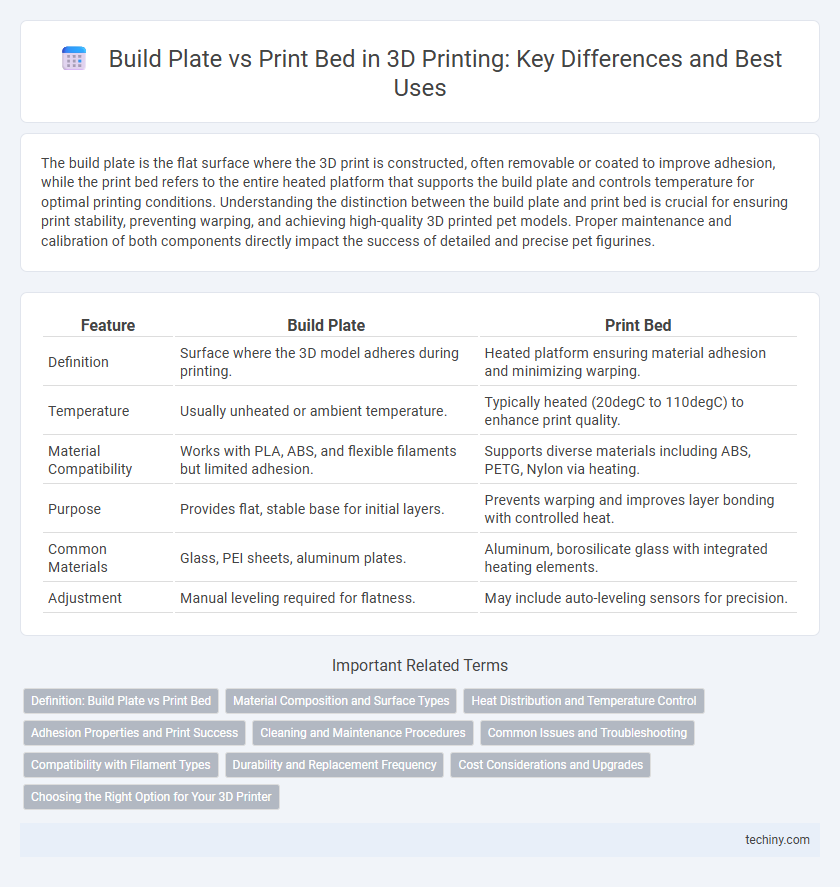The build plate is the flat surface where the 3D print is constructed, often removable or coated to improve adhesion, while the print bed refers to the entire heated platform that supports the build plate and controls temperature for optimal printing conditions. Understanding the distinction between the build plate and print bed is crucial for ensuring print stability, preventing warping, and achieving high-quality 3D printed pet models. Proper maintenance and calibration of both components directly impact the success of detailed and precise pet figurines.
Table of Comparison
| Feature | Build Plate | Print Bed |
|---|---|---|
| Definition | Surface where the 3D model adheres during printing. | Heated platform ensuring material adhesion and minimizing warping. |
| Temperature | Usually unheated or ambient temperature. | Typically heated (20degC to 110degC) to enhance print quality. |
| Material Compatibility | Works with PLA, ABS, and flexible filaments but limited adhesion. | Supports diverse materials including ABS, PETG, Nylon via heating. |
| Purpose | Provides flat, stable base for initial layers. | Prevents warping and improves layer bonding with controlled heat. |
| Common Materials | Glass, PEI sheets, aluminum plates. | Aluminum, borosilicate glass with integrated heating elements. |
| Adjustment | Manual leveling required for flatness. | May include auto-leveling sensors for precision. |
Definition: Build Plate vs Print Bed
The build plate is the flat surface on which the 3D object is initially formed during printing, acting as the foundation for layered material deposition. The print bed refers to the entire platform within the 3D printer that holds the build plate and often includes heating elements to ensure optimal adhesion and minimize warping. Understanding the distinction between the build plate as the direct contact surface and the print bed as the supporting assembly is essential for improving print quality and consistency in additive manufacturing.
Material Composition and Surface Types
Build plates and print beds in 3D printing differ primarily in material composition and surface types, impacting print adhesion and quality. Build plates often use materials like glass, aluminum, or PEI-coated surfaces, providing durability and smoothness, while print beds may incorporate heated elements with surfaces such as textured polycarbonate or adhesive tapes to enhance layer bonding. Selecting the right combination optimizes thermal conductivity, adhesion strength, and ease of print removal for various filament types.
Heat Distribution and Temperature Control
Heat distribution and temperature control are critical factors distinguishing a build plate from a print bed in 3D printing. A build plate often refers to the removable surface that supports the printed object, while the print bed includes integrated heating elements ensuring uniform temperature. Uniform heat distribution across the print bed minimizes warping and improves adhesion, resulting in higher-quality prints.
Adhesion Properties and Print Success
Build plates and print beds play crucial roles in 3D printing adhesion properties and overall print success. The build plate typically refers to the removable or replaceable surface, often coated to enhance adhesion and prevent warping, while the print bed is the stationary platform that supports the print during the process. Optimizing the material and temperature of both elements directly improves layer adhesion, reduces print failures, and ensures dimensional accuracy.
Cleaning and Maintenance Procedures
Build plate and print bed cleaning are crucial for ensuring optimal adhesion and print quality in 3D printing. Common maintenance procedures include removing residual filament with isopropyl alcohol and gently scraping off debris to maintain a smooth surface, preventing warping and print failures. Regularly checking for surface damage and recalibrating the bed height enhances print consistency and longevity of both build plate and print bed components.
Common Issues and Troubleshooting
Common issues with build plates and print beds in 3D printing include poor adhesion, warping, and uneven surfaces. Troubleshooting involves leveling the print bed accurately, cleaning the surface to remove debris or oils, and applying adhesives like glue sticks or painter's tape to improve first-layer bonding. Regular inspections and adjustments ensure consistent print quality and prevent common failures.
Compatibility with Filament Types
Build plates and print beds differ primarily in material and surface texture, directly affecting their compatibility with various filament types like PLA, ABS, PETG, and TPU. Build plates often feature interchangeable surfaces such as glass, PEI, or magnetic sheets tailored for specific filaments to enhance adhesion and reduce warping. Print beds, usually the integrated heated platforms of 3D printers, provide temperature control essential for printing flexible and high-temperature filaments, ensuring consistent layer bonding and print quality.
Durability and Replacement Frequency
Build plates typically offer higher durability due to their rigid materials like glass or aluminum, reducing wear over extended use. Print beds, often featuring flexible or heated surfaces, may require more frequent replacement because they endure thermal cycling and material adhesion stresses. Choosing a high-quality build plate can minimize downtime and maintenance costs associated with frequent bed replacements in 3D printing.
Cost Considerations and Upgrades
Build plates typically offer a cost-effective option for 3D printing due to their affordability and ease of replacement, ideal for users seeking budget-friendly upgrades. Print beds, often integrated with advanced features like heating elements or surface coatings, represent a higher initial investment but enhance print adhesion and quality, reducing failed prints and material waste. Investing in upgraded print beds can lower long-term expenses by improving print success rates, while build plates provide flexibility for quick, inexpensive swaps in multi-material or frequent-use environments.
Choosing the Right Option for Your 3D Printer
Selecting the right build plate or print bed is crucial for achieving optimal adhesion and print quality in 3D printing. Glass, PEI, and magnetic flexible build plates offer varying levels of durability, heat resistance, and ease of print removal, making material compatibility a key factor. Understanding your printer's hot end temperature, filament type, and bed leveling capabilities helps determine the ideal surface for consistent and successful prints.
Build Plate vs Print Bed Infographic

 techiny.com
techiny.com